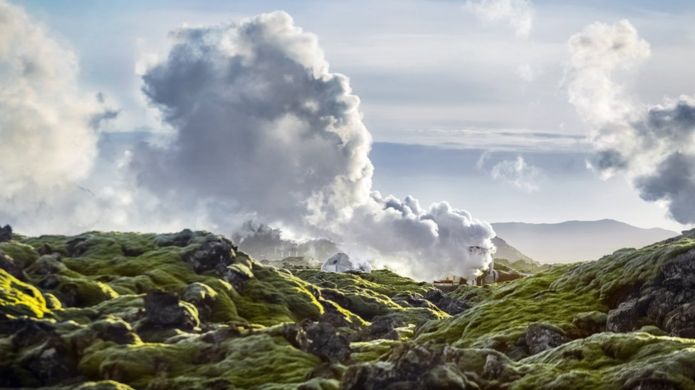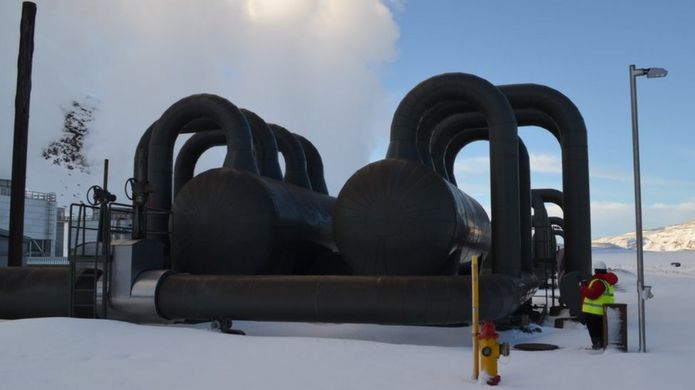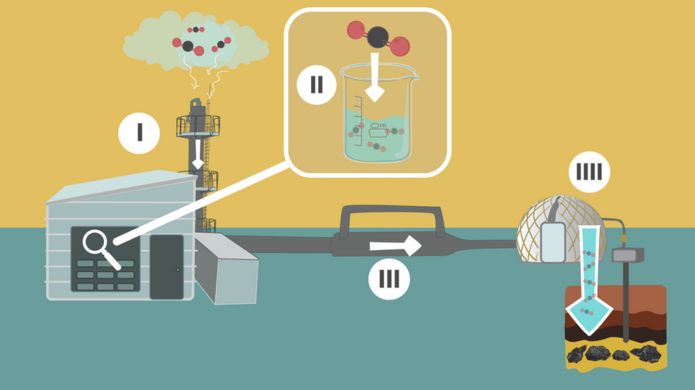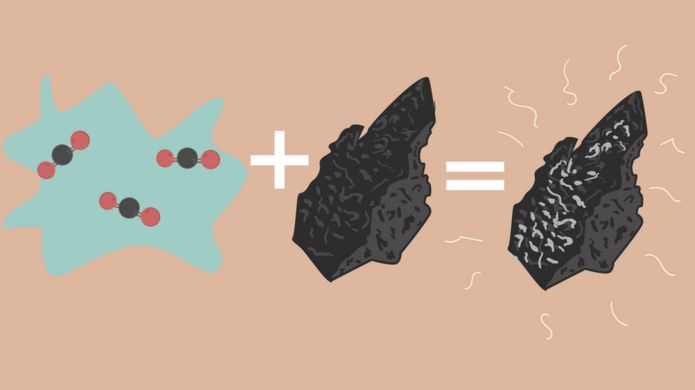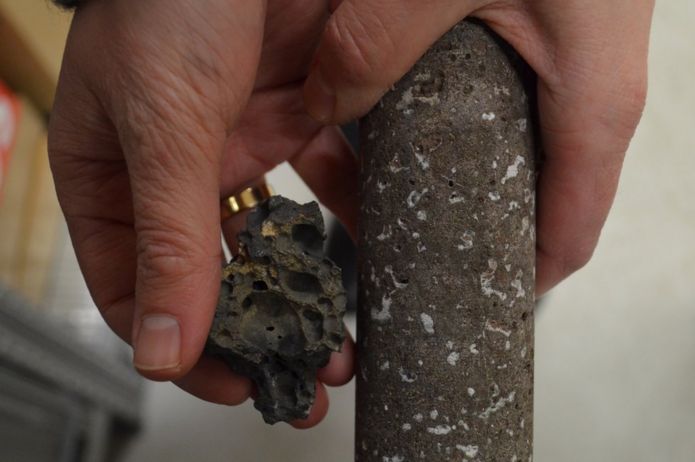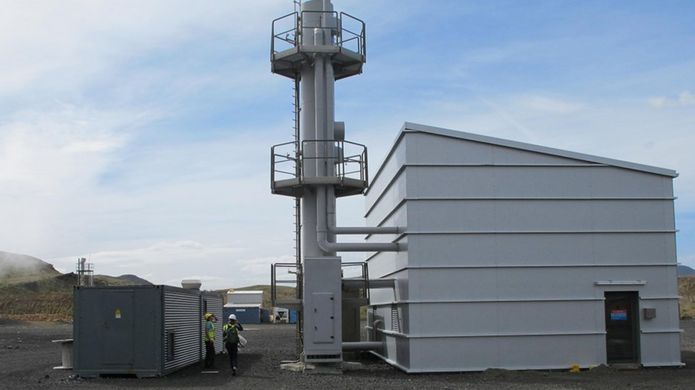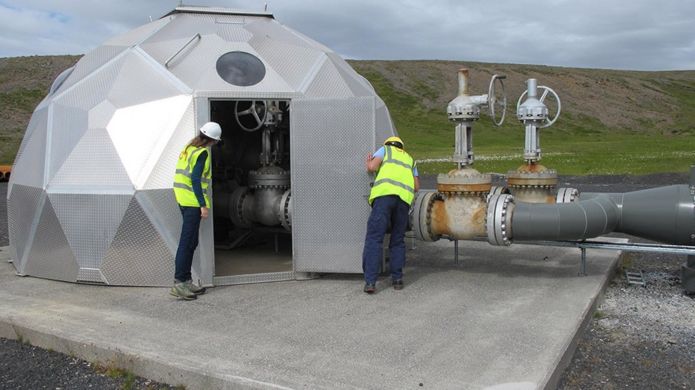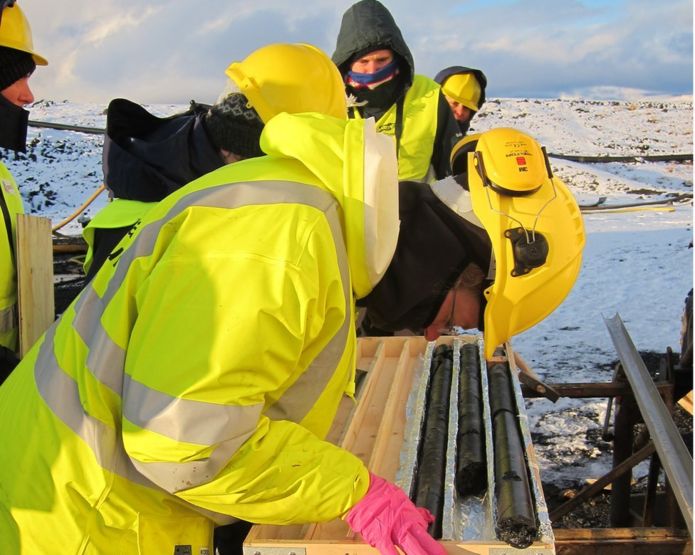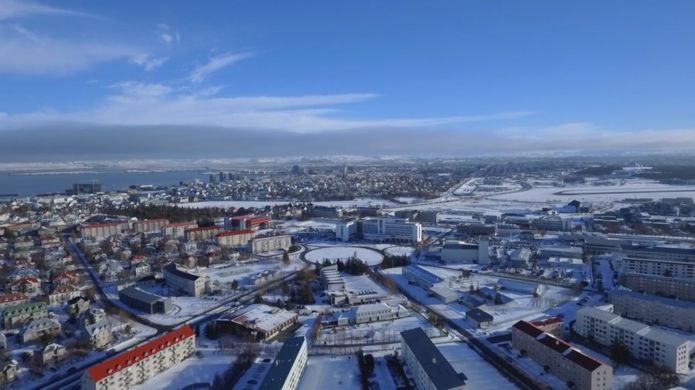Nested in the snow-covered mountains of western Iceland, a maze of turbines and pipes belches thick billows of steam. This mammoth structure is responsible for providing power to a country where 100% of the electricity comes from renewable sources.
The Hellisheidi power station, 25km (15 miles) outside Reykjavik, is Iceland's main geothermal plant, and is one of the largest in the world.
"Do you feel the vibrations beneath us?", says Edda Sif Aradottir, the plant's manager, splashing snow as she stomps her boot on the ground. "It's the steam coming into the turbines".
"This is a volcanic area. We harness the volcano's internal heat to generate electricity and provide hot water for the city's heating system, our swimming pools and showers. We Icelanders like our showers really hot!"
Hellisheidi is not just an accomplished provider of green energy. It is also the site for a scientific breakthrough; an experiment to capture carbon dioxide (CO2) and turn it into stone - forever.
Thus keeping this greenhouse gas out of the atmosphere and putting a dent in global warming.
"Mankind has been burning fossil fuels since the industrial revolution and we have already reached the tipping point for CO2 levels", says Dr Aradottir. "This is one of the solutions that can be applied to reverse that".
Called CarbFix, the project is pioneered by an international consortium led by Reykjavík Energy, the French National Centre for Scientific Research, the University of Iceland and Columbia University.
Since experiments began in 2014, it's been scaled up from a pilot project to a permanent solution, cleaning up a third of the plant's carbon emissions.
"More importantly, we are a testing ground for a method that can be applied elsewhere, be that a power plant, heavy industries or any other CO2 emitting source", says Dr Aradottir.
Making soda
With rising concentrations of atmospheric CO2, scientists have been testing "carbon capture and storage" (CCS) solutions since the 1970s.
CarbFix, however, stands out among CCS experiments because the capture of carbon is said to be permanent - and fast.
The process starts with the capture of waste CO2 from the steam, which is then dissolved into large volumes of water.
"We use a giant soda-machine", says Dr Aradottir as she points to the gas separation station, an industrial shed that stands behind the roaring turbines.
"Essentially, what happens here is similar to the process in your kitchen, when you are making yourself some sparkling water: we add fizz to the water".
The fizzy liquid is then piped to the injection site - otherworldly, geometric igloo-shaped structure 2km away. There it is pumped 1,000m (3,200ft) beneath the surface.
In a matter of months, chemical reactions will solidify the CO2 into rock - thus preventing it from escaping back into the atmosphere for millions of years.
In this seemingly magic feat, local geology plays a key part.
Porous rock
The breath-taking Icelandic landscape - with its hot springs, geysers and black beaches - is mainly made of basalt, a dark-grey porous rock formed from cooling of lava.
And basalt is "carbon's best friend", because it contains high amounts of calcium, magnesium and iron, which bind with the pumped CO2 to help it solidify into a mineral.
Sandra Snaebjornsdottir, a geologist working for CarbFix, has the evidence in her hands: a cylindrical sample drilled out from the site shows a smattering of chalky crystals encrusted in the basalt.
"These white bits are carbonates, or mineralised CO2", she says. "Fresh basalts are like sponges, with plenty of cavities that are filled with the CO2.
"Iceland is particularly favourable for this type of CCS simply because of the amount of basalt it's got".
Last year, 10,000 tonnes of CO2 were "digested" by CarbFix.
Yet this is tiny fraction - less than the yearly emissions of 650 Brits or 2,200 American cars.
And it becomes even more insignificant against the 30-40 gigatonnes of CO2 (a gigatonne is a billion tonnes) that modern humans pour into the atmosphere annually.
Despite its relatively small scale, experts anticipate CarbFix could be easy to repeat - thanks to the ubiquity of basalt around the world.
"Basalt is actually the most common rock type on Earth, it covers most of the oceanic floors and around 10% of the continents. Wherever there's basalt and water, this model would work", says Sandra Snaebjornsdottir.
Large basaltic areas are found in Siberia, Western India, Saudi Arabia and the Pacific Northwest.
And scientists are now looking at testing the model on the oceans to take advantage of the large areas of submarine basalt formations.
Potentially, basalt could solve all the world's CO2 problems says Sandra: "The storage capacity is such that, in theory, basalts could permanently hold the entire bulk of CO2 emissions derived from burning all fossil fuel on Earth."
Very thirsty
At the University of Iceland, research around CarbFix has been continuing since its pilot phase.
A desk-size replica of the pipes and pumps in Hellisheidi in a state-of-the-art lab allows Prof Sigurdur Gislason to scrutinize the process.
"Before the injection started in CarbFix, the consensus within the scientific community was that it would take decades to thousands of years for the injected CO2 to mineralise", says Prof Gislason explains.
"Then we found out that it was already mineralised after 400 days".
Reactions were a lot faster than anticipated partly because of the large amounts of water used to dissolve the CO2.
This however points to one of the project's Achilles heels - it is very water intensive.
"It needs over 25 tonnes of water per tonne of CO2," says Prof Gislason. "In Iceland we are blessed with lots of rain, but if you are doing this on the basaltic areas in India... their water is very precious".
Some critics warn high-tech fixes such as this one pose a bigger risk - that of distracting researchers and the public from the pressing need drastically to reduce greenhouse gases levels.
In a recent report, the European Academies Science Advisory Council warned that such technologies have "limited realistic potential" if emissions are not reduced.
"CarbFix is not a silver bullet. We have to cut emissions and develop renewable energies, and we have to do CCS too," says Prof Gislason.
We have to change the way we live, which has proved very hard for people to understand."
Part of our series Taking the Temperature , which focuses on the battle against climate change and the people and ideas making a difference.
This BBC series was produced with funding from the Skoll Foundation
Illustrations by Jilla Dastmalchi
